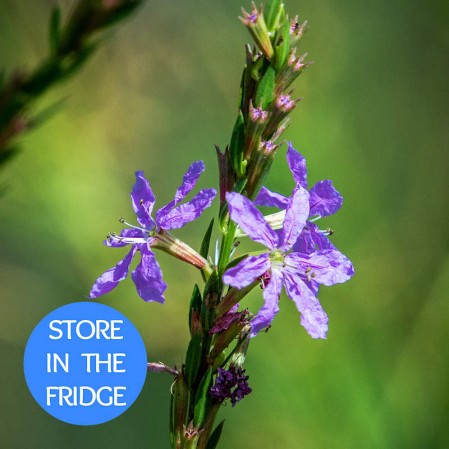Winged Loosestrife Seeds
Lythrum alatum
- HOW TO GROW
- FAST FACTS
HOW TO GROW
Sowing: Direct sow seeds in late fall; since they need light to germinate, plant them on the surface of the soil. For spring planting, mix the seeds with moist sand and store in the refrigerator for 60 days before planting. Keep the soil lightly moist until germination. This seed can also be started indoors 6-8 weeks before planting in the spring.
Growing: Seedlings are extremely vulnerable to heat and drought, and also have trouble competing with weeds. Water them regularly, since this plant loves moist soil and even tolerates standing water. These blossoms attract hummingbirds, bees, and butterflies. Deer tend to avoid this plant.
Harvesting: These blossoms do not perform well as cut flowers, and are best enjoyed outdoors.
Seed Saving: After the flowers fade, a slender pod will develop. Since the tiny seeds easily blows away, shake the seed out of the pods as soon as they open. Store the seed in a cool, dry place.
FAST FACTS
Common Names: Winged Lythrum
Latin Name: Lythrum alatum
Species Origin: US Native Wildflower
Type: Native Wildflowers
Life Cycle: Perennial
USDA Zones: 3, 4, 5, 6, 7, 8, 9, 10, 11
US Regions: Mountain, Plains/Texas, Midwest, Northern, Northeast, Southeast
Seeds per Ounce: 3,000,000
Stratification: Cold/Wet for 8 Weeks
Germination Ease: Stratify 8 Weeks
Sunlight: Full Sun
Height: 30 Inches
Color: Pink, Purple
Bloom Season: Blooms Early Summer, Blooms Late Summer, Blooms Early Fall
DESCRIPTION

HOW TO GROW
Sowing: Direct sow seeds in late fall; since they need light to germinate, plant them on the surface of the soil. For spring planting, mix the seeds with moist sand and store in the refrigerator for 60 days before planting. Keep the soil lightly moist until germination. This seed can also be started indoors 6-8 weeks before planting in the spring.
Growing: Seedlings are extremely vulnerable to heat and drought, and also have trouble competing with weeds. Water them regularly, since this plant loves moist soil and even tolerates standing water. These blossoms attract hummingbirds, bees, and butterflies. Deer tend to avoid this plant.
Harvesting: These blossoms do not perform well as cut flowers, and are best enjoyed outdoors.
Seed Saving: After the flowers fade, a slender pod will develop. Since the tiny seeds easily blows away, shake the seed out of the pods as soon as they open. Store the seed in a cool, dry place.
FAST FACTS
Common Names: Winged Lythrum
Latin Name: Lythrum alatum
Species Origin: US Native Wildflower
Type: Native Wildflowers
Life Cycle: Perennial
USDA Zones: 3, 4, 5, 6, 7, 8, 9, 10, 11
US Regions: Mountain, Plains/Texas, Midwest, Northern, Northeast, Southeast
Seeds per Ounce: 3,000,000
Stratification: Cold/Wet for 8 Weeks
Germination Ease: Stratify 8 Weeks
Sunlight: Full Sun
Height: 30 Inches
Color: Pink, Purple
Bloom Season: Blooms Early Summer, Blooms Late Summer, Blooms Early Fall



